|
Rispondi |
Messaggio 1 di 101 di questo argomento |
|
Cygnus (constelación)
De Wikipedia, la enciclopedia libre
Para otros usos de este término, véase Cygnus. Cygnus (el cisne) es una constelación del hemisferio norte que atraviesa la Vía Láctea. La disposición de sus principales estrellas hace que a veces sea conocida como la Cruz del Norte, en contraste con la constelación austral de la Cruz del Sur.
[editar] Características destacables
Deneb (α Cyg), la estrella más brillante de la constelación, ocupa uno de los vértices del llamado Triángulo de verano. Es una de las estrellas más luminosas de la Vía Láctea y es el prototipo de un grupo de variables que llevan su nombre, variables Alfa Cygni. Albireo (β Cyg) es una de las estrellas dobles más famosas del cielo nocturno. 61 Cygni, sistema binario cercano a 11,3 años luz, fue la primera estrella —excluyendo el Sol— cuya distancia a la Tierra fue medida.
Otras dos estrellas interesantes por distintos motivos son P Cygni, variable azul luminosa 700.000 veces más luminosa que nuestro Sol, y SS Cygni, variable cataclísmica prototipo de un subgrupo de novas enanas.
Asimismo, dentro de los límites de la constelación se encuentra Cygnus X-1, fuente de rayos X y uno de los máximos candidatos para ser considerado un agujero negro.
[editar] Estrellas principales
- α Cygni (Deneb), la estrella más brillante de la constelación con magnitud aparente 1,25, es una estrella supergigante blanco-azulada. Muy alejada de nosotros, no se conoce su distancia con exactitud, pudiendo estar entre 1600 y 3200 años luz. Su brillo ha de ser extraordinario, con una luminosidad entre 60.000 y 250.000 soles.
- β Cygni (Albireo), con magnitud 3,05, es una estrella doble donde las dos componentes, una amarilla y la otra azul, están separadas 34 arcsec. A su vez, la primera de ellas es una binaria espectroscópica.
- γ Cygni (Sadr), la segunda más brillante de la constelación con magnitud 2,23, supergigante amarilla a 1300 años luz.
- δ Cygni, de magnitud 2,86, una sistema estelar triple.
- ε Cygni (Giennah), de magnitud 2,48, una gigante naranja.
- ζ Cygni, estrella de bario con una enana blanca acompañante.
- η Cygni, gigante naranja de magnitud 3,88.
- λ Cygni, estrella múltiple de magnitud 4,75.
- ξ Cygni, supergigante naranja de magnitud 3,72 situada a unos 1200 años luz.
- ο Cygni, denominación compartida por dos estrellas distintas, ο1 Cygni y ο2 Cygni; curiosamente las dos son binarias eclipsantes.
- ρ Cygni, gigante amarilla de magnitud 4,00.
- σ Cygni, supergigante blanco-azulada de magnitud 4,26.
- τ Cygni, estrella múltiple con cuatro componentes; la estrella principal es una variable Delta Scuti.
- χ Cygni, supergigante de tipo S, cuyo brillo oscila entre magnitud 3,30 y 14,20, la mayor variación conocida en una estrella.
- ω1 Cygni, subgigante blanco-azulada de magnitud 4,94.
- ω² Cygni (Ruchba), estrella doble cuya observación es muy interesante por el contraste entre las dos componentes, una roja y otra azul.
- 11 Cygni, estrella Be de magnitud 6,03.
- 16 Cygni, sistema triple compuesto por dos enanas amarillas parecidas al Sol, y una enana roja: se ha descubierto un planeta extrasolar alrededor de una de las estrellas amarillas.
- 17 Cygni, enana amarilla de magnitud 4,99 distante 68 años luz.
- 29 Cygni, con magnitud 4,96, es una estrella Lambda Bootis y una variable Delta Scuti.
- 41 Cygni, gigante luminosa blanco-amarilla de magnitud 4,01.
- 52 Cygni, gigante amarillo-anaranjada de magnitud 4,22.
- 59 Cygni (V832 Cygni), sistema estelar de magnitud 4,74 cuya estrella primaria es una estrella Be.
- 61 Cygni, estrella binaria formada por dos enanas naranjas en las cercanías del Sistema Solar (11,36 años luz), una de las mejores para observar con prismáticos.
- P Cygni, estrella hipergigante variable luminosa azul, una de las más brillantes de la galaxia. Su magnitud aparente es 4,8.
- X Cygni, variable cefeida cuyo brillo varía entre magnitud 5,85 y 6,91 en un período de 16,3863 días.
- RV Cygni, estrella de carbono y variable semirregular de brillo variable entre magnitud 10,8 y 12,4.
- RW Cygni y BC Cygni, supergigantes rojas de gran tamaño.
- SS Cygni, posiblemente la estrella variable más observada del cielo, cuya magnitud varía entre 8,3 y 12,2.
- TT Cygni, estrella de carbono con una cubierta de polvo alrededor.
- CH Cygni y CI Cygni, estrellas simbióticas.
- KY Cygni, una colosal supergigante roja, una de las más grandes que se conocen; su diámetro es 1420 veces mayor que el del Sol.
- V444 Cygni, binaria eclipsante que contiene una estrella de Wolf-Rayet.
- V478 Cygni, también binaria eclipsante compuesta por dos estrellas calientes de tipo O.
- V1687 Cygni, sistema binario masivo compuesto por una supergigante azul y una estrella de Wolf-Rayet.
- HD 184499, estrella con más de 10.000 millones de años de antigüedad de magnitud 6,61.
- HD 188753, con un posible planeta extrasolar; sería el primero descubierto alrededor de un sistema estelar triple.
- Estrella de Campbell (BD+30 3639), estrella central de la nebulosa planetaria PK 064+05 1.
- A11 y A36, estrellas masivas que probablemente forman parte de la asociación estelar Cygnus OB2.
- WR 142, estrella de Wolf-Rayet muy caliente y compacta, del raro tipo espectral WO.
- Gliese 777, sistema binario en donde la componente principal tiene dos planetas extrasolares.
- GJ 1245 (V1581 Cygni), sistema estelar triple a unos 15 años luz de la Tierra.
- GJ 1253, tenue enana roja distante 30 años luz.
- Cygnus X-1, un sistema binario compuesto por una supergigante azul y otro objeto masivo, probablemente un agujero negro.
[editar] Objetos de cielo profundo
- Nebulosa Norteamérica (NGC 7000), situada al este de Deneb, su forma recuerda a la del continente norteamericano.
- Nebulosa Pelícano (IC 5070), cuyo nombre se debe a la forma similar a esta ave.
- Nebulosa del Velo NGC 6960, NGC 6992 y NGC 6995, es el resto de una antigua supernova.
- Nebulosa Medialuna (NGC 6888), formada por una estrella de Wolf-Rayet (WR 136).
- Nebulosas planetarias NGC 6826 (Nebulosa del Ojo que Parpadea), NGC 6884, NGC 7027.
- Nebulosa del Huevo (RAFGL 2688), protonebulosa planetaria bipolar.
- Galaxia NGC 6946, en el límite con la constelación de Cepheus, donde se han observado varias supernovas.
- Cygnus OB2, una de las asociaciones estelares más ricas de la Vía Láctea y que no sólo contiene algunas de las estrellas más brillantes de la galaxia -cómo por ejemplo Cygnus OB2 12- sino que también es considerada por algunos cómo un cúmulo globular joven.
[editar] Historia y mitología
En la mitología griega, la constelación representaba varios cisnes legendarios. Así, Zeus se disfrazó de cisne para seducir a Leda, de la que, según una versión, nació Helena de Troya.
Orfeo fue transformado en cisne tras su muerte, y se dijo que había sido puesto en el cielo junto a su lira (Lyra).
Finalmente, se cuenta que un rey de nombre Cicno era un pariente o amante de Faetón. El hijo de Apolo, Faetón, engañó a su padre permitiéndole montar en el carro del Sol, pero perdió el control y fue abatido por Zeus. Después de la muerte de Faetón, Cicno se sumergió en el río Erídano para encontrarle. Lo hizo en tantas ocasiones, que fue transformado en el cisne Cygnus, y es visible hoy en el cielo.
Por otra parte, Cygnus, junto a otras constelaciones en el signo zodiacal de Sagitario (en concreto Lyra y Aquila, junto al propio Sagitario), pueden tener un papel significativo en el origen del mito de los Pájaros del Estínfalo, uno de los doce trabajos de Hércules.
http://es.wikipedia.org/wiki/Cygnus_(constelaci%C3%B3n)
|
|
|
|
Rispondi |
Messaggio 2 di 101 di questo argomento |
|
|
|
|
Rispondi |
Messaggio 3 di 101 di questo argomento |
|
by Andrew Collins
from AndrewCollins Website
The three main Giza pyramids, as viewed from the edge of the Maadi Formation
southwest of the Third Pyramid, taken in May 2005
When I wrote THE CYGNUS MYSTERY, I knew that among the many incredible claims it would make, one alone would court fierce criticism, and this was the apparent connection between Giza and the Cygnus constellation. Over the years I have seen how other new theories concerning the hidden mysteries of the plateau have been ripped to shreds by detractors, and then dissected piece by piece until nothing is left intact.
It started with the theories contained in Robert Bauval and Adrian Gilbert's seminal classic THE ORION MYSTERY back in 1994, and has continued ever since with any theory that veers even slightly away from the straight and narrow path of orthodoxy Egyptology. Yet strangely, it is not usually the Egyptologists who start the carnage, but other researchers and writers in the fields of either revisionist history or archaeoastronomy, neither of which are accepted as mainstream subjects.
So by suggesting that the three main pyramids at Giza, as well as the plateau as a whole, reflect sight lines targeting the rising and setting of Cygnus, associated by the Ancient Egyptians with the falcon-headed celestial figure dwn-'nwy, was never going to be taken lying down by the critics.
Thus when my friend and colleague Rodney Hale rung me excitedly one morning in January 2005 to say that he had superimposed the three 'wing' or 'cross' stars of Cygnus (Gienah, aka epsilon Cygni; Sadr, aka gamma Cygni, and delta Cygni) with the Giza pyramids and it was a perfect match, I knew then that if this were ever to reach publication then it was going to cause a furore that would eclipse anything I had ever written before about Ancient Egypt.
THE CYGNUS-GIZA CORRELATION
Rodney had decided to compare the stars of Cygnus with the Giza pyramids after the idea came to him in a flash of inspiration as he lay in bed one night unable to sleep. Yet it must also have stemmed from the fact that when THE ORION MYSTERY was first published Rodney, having embracing such new ideas regarding the astronomy of the Ancient Egyptians, became disappointed when in 1995 he attempted to superimpose Orion's 'belt' stars over the Giza pyramids, with the following results:
Relative positions of the three 'belt' stars of Orion as overlaid upon the Giza pyramids
as done by Rodney Hale in 1995, using both a photograph of the stars
and as they appear in the Skyglobe program 3.5
They simply do not match, with the star corresponding to the Third Pyramid, Mintaka (delta Orionis), falling towards the southwest edge of the monument. Of course, the whole thing could simply have been a symbolic gesture on the part of the Ancient Egyptians, and thus was not meant to be precise. Yet still, it was a shame that the correlation was not exact.
Even more despair came for Rodney, a technical engineer by trade, when he attempted to match the remaining stars of Orion with other pyramid fields, as is proposed by Bauval and Gilbert in THE ORION MYSTERY.
Map of the Orion constellation
Unfortunately, Saiph ('sword', kappa Orionis), which as Orion's right knee is south of the belt stars, fell short of its predicted target - the ruined pyramid of Djedefre of Abu Rawash, while Bellatrix (gamma Orionis), the left shoulder of Orion, is situated some distance away from its target - the so-called 'Unfinished Pyramid' at Zawiyat al-Aryan.
Even more confusing was that Orion's two brightest stars Rigel (beta Orionis) and Betelgeuse (alpha Orionis) do not mark an ancient monument of any kind. Once again, the correlation might not have needed to be precise, but it was a shame that the theory was not as tight as he might have liked it to be. Proposals of this kind need precision for the soul to take them seriously.
Orion superimposed (upside down) on 1927 map of Cairo, showing
the relevant pyramid fields
So now it seemed that for Rodney the 'wing' stars of Cygnus, linked to the plateau through its associations with the cult of Sokar - a falcon-headed god of the dead who presided over Rostau, ancient Giza, and was the earthly counterpart of the celestial sky falcon god dwn-'nwy - could be superimposed over the three main pyramids.
-
Was this simply coincidence?
-
Had it been by grand design, created by the great architect of the Great Pyramid, or was the cosmic joker at work here?
The simple answer is that neither of us could be sure. However, I decided to publish these controversial findings in THE CYGNUS MYSTERY. Naturally, there was a certain amount of hesitation, but I wanted for the Cygnus-Giza ground-sky alignment to speak for itself.
Strangely, Adriano Forgione the editor of Italy's HERA magazine told me that a while back a young reader had written to the letters' page asking whether it was possible that the stars of Cygnus created a better ground-sky match than those of Orion's belt. Why exactly this person should have suggested this is unclear, and Adriano is unable now to find his name. Still, it was a sign that I was doing something right.
Ground-sky overlay using the stars of Cygnus on a modern map of the Giza plateau.
The Cygnus stars are in red, with those of Orion's belt in green.
Actual photograph of the stars were used for this purpose
MOUND OF CREATION
What was also more attractive about the Cygnus-Giza correlation is that because the constellation's 'wing' stars are wider apart than those of Orion's belt, it means that, pro-rata, all its other main stars superimpose nicely on the plateau, highlighting other potentially interesting features.
For instance, Albireo (beta Cygni), the 'beak' star falls in the area of Gebel Ghibli (Arabic for 'southern hill'), a curious rock formation a few hundred meters to the south of the Great Sphinx. Robert Bauval and Simon Cox in the former's book THE SECRET CHAMBER (1999) proposed that Gebel Ghibli might have acted as a physical representation of a mythological primeval hill, or Mound of Creation.
Cox had already investigated this strange hillock, after it had been highlighted as significant in the remarkable landscape geometry of David Ritchie. Cox sensed that it held the key to locating the lost Shetayet shrine of Sokar, said to have been somewhere in the area. Ritchie had felt that it was a 'gateway' into Giza's hidden dimensions.
The previous year, 1998, in my own book GODS OF EDEN, I had suggested that just such a Mound, or Island, of Creation once existed on or close to the plateau, since one is mentioned in the enigmatic Edfu Building Texts, which describe a primordial world that thrived in the vicinity of Memphis/Giza in pre-dynastic times. Since these texts also referred to a well-like structure as being on the 'Island', which led down into an underworld-duat realm (whether real or symbolic), I predicted that a significant well would also be found on this symbolic Mound of creation.
Just such a well structure was discovered by myself in May 2005 amid the modern Islamic cemetery just north of Gebel Ghibli. Known as Beer el-Samman, it is protected by sacred sycamore fig trees - descendants of those mentioned in the Inventory Stela and in the Ancient Egyptian story of Sinuhe.
It is dedicated to a holy man named Hammad el-Samman, said to have once occupied the well in some bygone age. According to a little known tradition still held by the village elders of Nazlet el-Samman (named after the saint), Hammad el-Samman guarded the entrance to an underground city or palace located beneath Nazlet el-Samman, which is due east of the Great Sphinx (where Edgar Cayce predicted that the Egyptians Hall of Records would be found).
Thus to find that the Cygnus star Albireo, the mouth or gullet or the celestial bird, fell nearby, albeit beyond the long linear stone structure known as the Wall of Crows (see below), was interesting indeed, and worthy of further investigation.
THE FURORE BEGINS
THE CYGNUS MYSTERY was published, finally, in November 2006, and instantly the furore began. Hundreds of postings on phorums such as The Hall of Maat and the Graham Hancock website fueled the Cygnus vs. Orion debate beyond anything I could ever have imagined.
Strangely, most posts were fairly positive, especially after able researchers went away and did their own Cygnus-Giza overlay, and saw that it was accurate. Others, however, would not even accept that Cygnus was known to the Ancient Egyptians, never mind it being linked with the plateau.
THE DENEB SPOT
One question which did crop up was: What on the plateau mark's Deneb (alpha Cygni), the brightest star in Cygnus? The answer is that it falls northwest of the Second Pyramid on the edge of the so-called Western Cemetery, which lies west of the Great Pyramid. This is made up of dozens of mastaba tombs from the Fourth, Fifth and Sixth Dynasties, which belong to those nobles and their families connected with the royal royal dynasties. They were built for priests, priestesses, prophets, tradesmen and arguably even the architect of the Great Pyramid.
The Deneb spot covers a fairly large mastaba designated LG14, after the numbering of German Egyptologist Carl Richard Lepsius (1810-1884), who surveyed the plateau, and produced an impressive map dated 1842 (see below).
The Lepsius map of 1842 showing the Cygnus stars overlaid in red.
Note the Deneb spot obscuring mastaba LG14 on the edge of the Western Cemetery
Lepsius found the tomb to be devoid of any artifacts or inscriptions, and thus it was simply catalogued and forgotten about. Nothing more is currently known about LG14, and there is every chance that, if not pillaged in ancient times, it was built but never used. As such, no further light can be thrown on the Deneb spot, as we refer to it.
Deleted section
Whether any of this has anything to do with the proximity, not far away of the Deneb spot, must remain speculation, and in my opinion, if the Cygnus-Giza correlation is meaningful, then I suspect that the Deneb spot played an altogether different role to that of the three 'wing' stars that correspond to the three main Giza pyramids.
Perhaps what we are looking for here is underground, or it is simply the position of a sight line overlooking the rest of the plateau. Either way, the Cygnus-Giza correlation should not be dismissed simply because Deneb does not hit anything obviously important, especially since Orion's own brightest stars, Rigel and Betelgeuse, fail themselves to mark any ancient monument.
The John Perring's 1837 map of the Giza plateau.
The Cygnus stars are in red. Note also the 'well' (Beer el-Samman)
and 'sycamores' marked between the Great Sphinx and Gebel Ghibli.
Note also the proximity of the 'beak star' Albireo (beta Cygni).
THE PROPER MOTION OF STARS
One serious criticism of the Cygnus-Giza correlation related to the idea of a star's proper motion. This is the slow drift of extra-galactic stars against the background of other stars caused either by its movement in relation to its own galaxy, or because of earlier near collisions with other stars or stellar objects.
It was a valid point, and so a check on the proper motion of Cygnus's key stars produced the following slow movements in any one year against the stellar background:
|
Alpha Cygni
RA: 0.003 arcsec/a or mas/yr
DEC: 0.002
Beta Cygni
RA: 0.002
DEC: -0.002
Delta Cygni
RA: 0.053
DEC: 0.047
Gamma Cygni
RA: 0,004
DEC: 0
Epsilon Cygni
RA: 356.16
DEC: 330.28
|
When this data is translated on to a map of the Cygnus constellation, the following takes place over the 4,000 year period from 2000 BC to AD 2000:
The proper motion of the principal stars of Cygnus over a period of 4,000 years,
from 2000 AD back to 2000 BC, using the Home Planet program
Now all this might look confusing, but what it says is that, as Robert Bauval and Graham Hancock have said in connection with the 'belt' stars of Orion, there is no significant shift in the relative positions of the stars over this time.
Only one star in Cygnus is moving faster than the rest, and this is Gienah (epsilon Cygni), which does shift slightly with respect to the Cygnus-Giza overlay, as is shown below.
The relative shift of the star Gienah (epsilon Cygni)
with respect to its position in relation to the Third Pyramid over a period of 4,000 years
As is plain to see, the shift is minimal, and does in no way change anything regarding the original proposal of the Cygnus-Giza correlation. The other two Cygnus 'wing' stars, delta Cygni, corresponding with the Great Pyramid, and Sadr (gamma Cygni), corresponding with the Second Pyramid, move so little that it is unnoticeable on a small scale map of the pyramid field.
We are, however, not leaving the matter here. Rodney Hale and I shall continue to examine other astronomical programs that provide the proper motion of stars, and check to see whether they correspond with the shifts in position offered here.
THE RIGHT MAP
Another criticism of the Cygnus-Giza correlation was the suggestion that Rodney Hale and I had not used an accurate map of the plateau when creating the superimposition. In order to counter this argument, Rodney superimposed the 'wing' stars of Cygnus and the 'belt' stars of Orion over four different maps of the plateau, and then brought them together in one diagram (seen below).
The variations of pyramid positions relative to the stars
of both Cygnus (in red) and Orion (in green) using four different maps
This shows the width of variations of pyramid positions relative to the stars of both Cygnus and Orion.
As we can see, there is very little difference in the positions of the pyramids from one map to the next, making no difference whatsoever to the relative positions of either the Cygnus or Orion stars when superimposed on the plateau. Without any question, the Cygnus stars align much better than those of Orion.
Once again, such ground-sky correlations, if meaningful, might be symbolic alone, and not need to be actual, allowing still for the possibility that the three pyramids represent Orion and not Cygnus. However, visually Cygnus wins hands down. Rodney Hale and I will continue to consider other maps or photographs of the plateau with regards to the Cygnus-Giza correlation.
THE HOLY WELL BEER EL-SAMMAN
The final criticism of the Cygnus-Giza correlation among the posts on the various online phorums was that the holy well Beer el-Samman never existed, or that it was irrelevant to the debate.
These are quite clearly ridiculous observations. Not only does the well appear on the Perring map of 1837, which shows its location prior to the siting of the modern Islamic cemetery, but it also appears on the Lepsius map of 1842 (see below):
The well Beer el-Samman marked as a dot between two palm trees and two sycamore fig trees.
On the left (south) we see the rock outcrop Gebel Ghibli (Arabic for 'southern hill'),
and on the right the Great Sphinx.
At the left-hand base is the end of the linear feature known as the Wall of the Crow
There seems little question that this holy well would have played a function in Ancient Egyptian geomythics, especially since it falls inside the plateau, being placed as it is on the northside of the so-called Wall of the Crow, a linear stone feature made of cyclopean blocks which dates to the late Fourth Dynasty and is thought to be part of the plateau's southern boundary wall.
I consider it possible that Beer el-Samman is the structure referred to in the Edfu Building Texts as bw-hmn, which the Egyptologist EAE Reymond interpreted as 'place of the well' (THE ORIGINS OF THE EGYPTIAN TEMPLE, 181,200). I suspect it was in magical rites associated with Hathor, possibly a female patron of the plateau, and possibly Nut, the sky-goddess, whom Dr Robin Wells identifies with the Milky Way. It might equally have some connection with the cult of Sokar, who was guardian of underworld realms, which were forever in darkness.
Beer el-Samman corresponds with the Ain Shams (Eye of the Sun) holy spring that lies beneath an ancient sycamore fig at El Matariyeh, which once formed part of the ancient city of Heliopolis. This particular spring in Coptic Christian tradition is said to have sprung up miraculously when the Holy Family stopped here in need of water during the Flight through Egypt.
However, it is more likely to date back to dynastic times, particularly as its accompanying sycamore is perhaps a descendent of one said to have existed in Heliopolis. It was sacred to the goddess Nut, who was occasionally shown in Ancient Egyptian art as standing in a sycamore tree pouring either water or wine from a jar on to a human-headed bird, representing the ba, or soul, of a deceased person. At its base was depicted just such a holy well, or spring.
Often Hathor replaced Nut in this scene, showing the relationship between the two goddesses, who have much in common.
The dual placement of the two holy springs, one at Giza and the other at Heliopolis, one dedicated most probably to Hathor and the other to Nut, provides credence to the belief that a sight line existed between these two places. Between 3000-2500 BC this Giza-Matariyeh sight line targeted the rising of Deneb, the brightest star in Cygnus, which would have become visible on the northeast horizon somewhere between azimuth 46.5-47.5 degrees.
As to the present day existence of Beer el-Samman, this is proved by one of a number of photographs Sue Collins and I took of it in May 2005, after risking our freedom to enter the Islamic cemetery, which is strictly out of bounds to non-Muslims. As you can see it is a regular artesian well, stone lined, which taps into the water table beneath the plateau.
Beer el-Samman as it appears today in the Islamic cemetery,
shaded by a sycamore fig tree.
Its proximity to Gebel Ghibli should be noted
I doubt very much whether it leads directly to a lost underworld domain, although it is interesting that the lowest level of the so-called 'Tomb of Osiris', discovered in the 1920s beneath the causeway to the Second Pyramid by Egyptologist Salim Hassan, possesses a pit thought to lead into an unexplored tunnel now beneath the present water table, this being high enough to fill the existing chamber to a depth of at least 1.5 meters.
Could the story of the holy man Hamman el-Samman guarding the entrance to an underground palace or city be the memory of real passages that permeate the living rock beneath the plateau's water line?
Conclusions
One one question remains: does the Cygnus-Giza correlation work? In the knowledge that Dr Robin Wells, following an examination of the astronomical orientation of the causeway of Sahure's sun temple at Abu Ghourab, south of the Giza plateau, concluded that this king, who opened the Fifth Dynasty, singled out Deneb, Cygnus's brightest star, as in some way special, then I think the answer is going to be 'yes'.
Yes, in that such superimpositions, whether involving the stars of Orion or Cygnus, put into perspective the hidden dimensions of places such as the Giza plateau. Part of me wants to dismiss the Cygnus-Giza correlation as the actions of the wily Cosmic Joker having his fun. Yet then again, if I had dismissed the correlation then I would probably never have found Beer el-Samman, or turned up the information on the strange bird catacomb beyond the northwestern edge of the plateau, which Vyse and Perring wrote contained 'bird mummies', as well as 'part of a large bird '.
Thus in conclusion, I consider that the Cygnus-Giza correlation has not hindered my investigations on the plateau in the least. In fact, it has given it an entirely new dimension that I now intend exploring to its fullest.
My thanks go out to Rodney Hale, Nigel Skinner Simpson, and Sue Collins who helped in the preparation of this article.
|
|
|
|
Rispondi |
Messaggio 4 di 101 di questo argomento |
|
THE CYGNUS-GIZA CORRELATION - THE FACTS AND ALIGNMENTS IN PICTORIAL FORM
A Reply to Critics by Andrew Collins
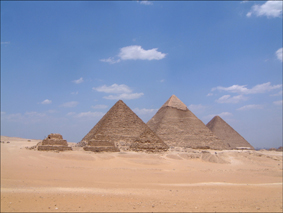
The three main Giza pyramids, as viewed from the edge of the Maadi Formation
southwest of the Third Pyramid, taken in May 2005 (Pic credit: Andrew Collins).
When I wrote THE CYGNUS MYSTERY, I knew that among the many incredible claims it would make, one alone would court fierce criticism, and this was the apparent connection between Giza and the Cygnus constellation. Over the years I have seen how other new theories concerning the hidden mysteries of the plateau have been ripped to shreds by detractors, and then dissected piece by piece until nothing is left intact. It started with the theories contained in Robert Bauval and Adrian Gilbert's seminal classic THE ORION MYSTERY back in 1994, and has continued ever since with any theory that veers even slightly away from the straight and narrow path of orthodoxy Egyptology. Yet strangely, it is not usually the Egyptologists who start the carnage, but other researchers and writers in the fields of either revisionist history or archaeoastronomy, neither of which are accepted as mainstream subjects.
So by suggesting that the three main pyramids at Giza, as well as the plateau as a whole, reflect sight lines targeting the rising and setting of Cygnus, associated by the Ancient Egyptians with the falcon-headed celestial figure dwn-'nwy, was never going to be taken lying down by the critics. Thus when my friend and colleague Rodney Hale rung me excitedly one morning in January 2005 to say that he had superimposed the three 'wing' or 'cross' stars of Cygnus (Gienah, aka epsilon Cygni; Sadr, aka gamma Cygni, and delta Cygni) with the Giza pyramids and it was a perfect match, I knew then that if this were ever to reach publication then it was going to cause a furore that would eclipse anything I had ever written before about Ancient Egypt.
THE CYGNUS-GIZA CORRELATION
Rodney had decided to compare the stars of Cygnus with the Giza pyramids after the idea came to him in a flash of inspiration as he lay in bed one night unable to sleep. Yet it must also have stemmed from the fact that when THE ORION MYSTERY was first published Rodney, having embracing such new ideas regarding the astronomy of the Ancient Egyptians, became disappointed when in 1995 he attempted to superimpose Orion's 'belt' stars over the Giza pyramids, with the following results:
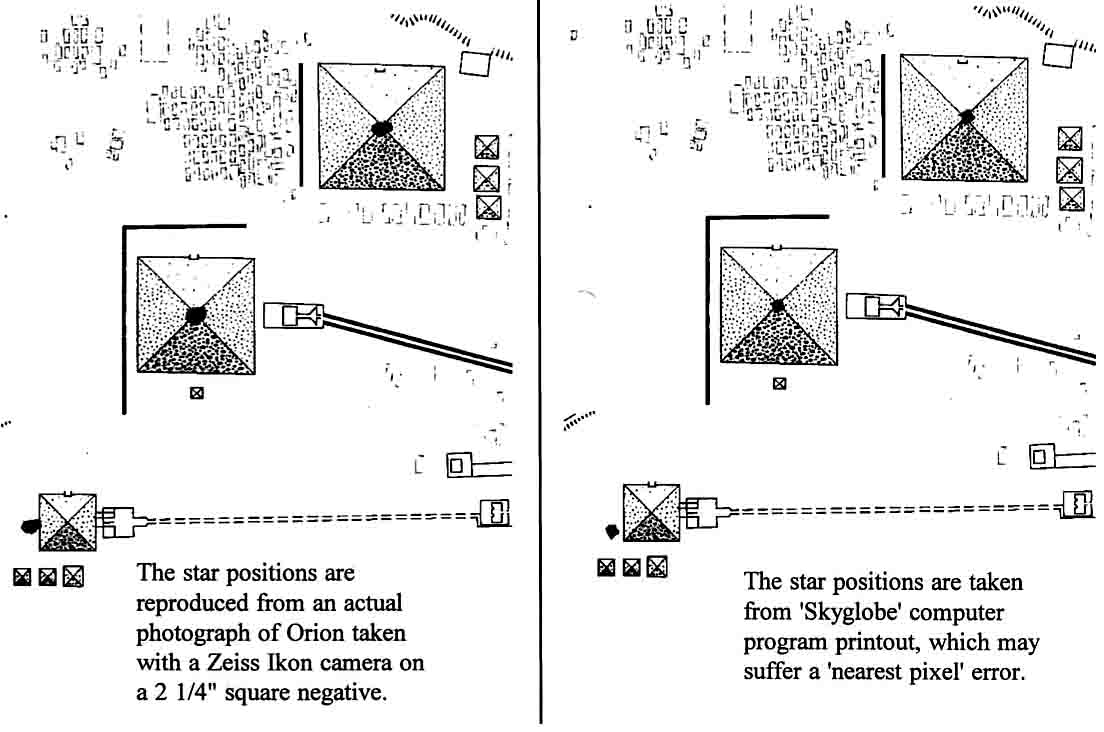
Relative positions of the three 'belt' stars of Orion as overlaid upon the Giza pyramids as done by Rodney Hale in 1995, using both a photograph of the stars and as they appear in the Skyglobe program 3.5 (Pic credit: Rodney Hale)
They simply do not match, with the star corresponding to the Third Pyramid, Mintaka (delta Orionis), falling towards the southwest edge of the monument. Of course, the whole thing could simply have been a symbolic gesture on the part of the Ancient Egyptians, and thus was not meant to be precise. Yet still, it was a shame that the correlation was not exact. Even more despair came for Rodney, a technical engineer by trade, when he attempted to match the remaining stars of Orion with other pyramid fields, as is proposed by Bauval and Gilbert in THE ORION MYSTERY.
|
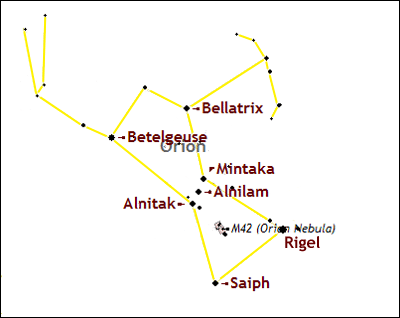
Map of the Orion constellation.
|
Unfortunately, Saiph ('sword', kappa Orionis), which as Orion's right knee is south of the belt stars, fell short of its predicted target - the ruined pyramid of Djedefre of Abu Rawash, while Bellatrix (gamma Orionis), the left shoulder of Orion, is situated some distance away from its target - the so-called 'Unfinished Pyramid' at Zawiyat al-Aryan. Even more confusing was that Orion's two brightest stars Rigel (beta Orionis) and Betelgeuse (alpha Orionis) do not mark an ancient monument of any kind. Once again, the correlation might not have needed to be precise, but it was a shame that the theory was not as tight as he might have liked it to be. Proposals of this kind need precision for the soul to take them seriously. |
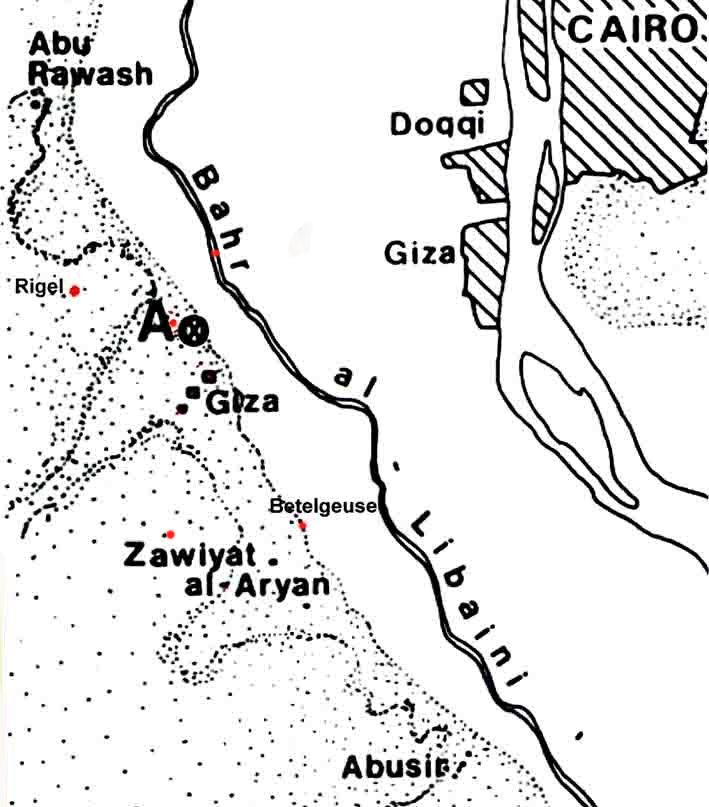
Orion superimposed (upside down) on 1927 map of Cairo, showing
the relevant pyramid fields (Pic credit: Rodney Hale).
So now it seemed that for Rodney the 'wing' stars of Cygnus, linked to the plateau through its associations with the cult of Sokar - a falcon-headed god of the dead who presided over Rostau, ancient Giza, and was the earthly counterpart of the celestial sky falcon god dwn-'nwy - could be superimposed over the three main pyramids. Was this simply coincidence? Had it been by grand design, created by the great architect of the Great Pyramid, or was the cosmic joker at work here? The simple answer is that neither of us could be sure. However, I decided to publish these controversial findings in THE CYGNUS MYSTERY. Naturally, there was a certain amount of hesitation, but I wanted for the Cygnus-Giza ground-sky alignment to speak for itself. |
|
|
|
Rispondi |
Messaggio 5 di 101 di questo argomento |
|
Strangely, Adriano Forgione the editor of Italy's HERA magazine told me that a while back a young reader had written to the letters' page asking whether it was possible that the stars of Cygnus created a better ground-sky match than those of Orion's belt. Why exactly this person should have suggested this is unclear, and Adriano is unable now to find his name. Still, it was a sign that I was doing something right.
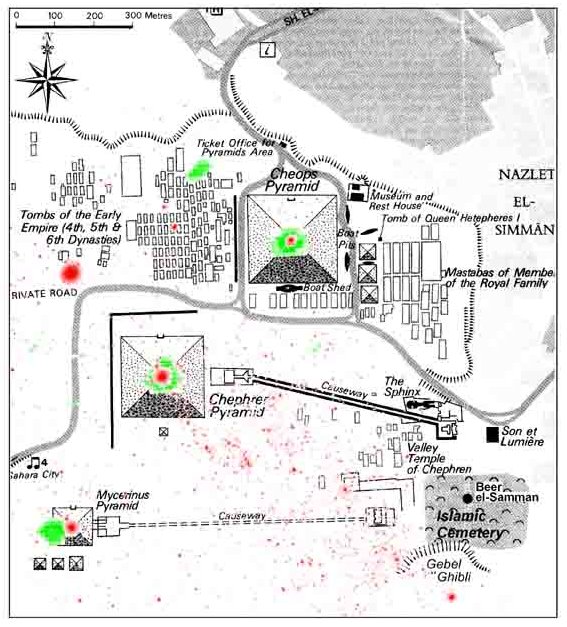
Ground-sky overlay using the stars of Cygnus on a modern map of the Giza plateau. The Cygnus stars are in red, with those of Orion's belt in green. Actual photograph of the stars were used for this purpose (Pic credit: Rodney Hale).
MOUND OF CREATION
What was also more attractive about the Cygnus-Giza correlation is that because the constellation's 'wing' stars are wider apart than those of Orion's belt, it means that, pro-rata, all its other main stars superimpose nicely on the plateau, highlighting other potentially interesting features. For instance, Albireo (beta Cygni), the 'beak' star falls in the area of Gebel Ghibli (Arabic for 'southern hill'), a curious rock formation a few hundred metres to the south of the Great Sphinx. Robert Bauval and Simon Cox in the former's book THE SECRET CHAMBER (1999) proposed that Gebel Ghibli might have acted as a physical representation of a mythological primeval hill, or Mound of Creation. Cox had already investigated this strange hillock, after it had been highlighted as significant in the remarkable landscape geometry of David Ritchie. Cox sensed that it held the key to locating the lost Shetayet shrine of Sokar, said to have been somewhere in the area. Ritchie had felt that it was a 'gateway' into Giza's hidden dimensions.
The previous year, 1998, in my own book GODS OF EDEN, I had suggested that just such a Mound, or Island, of Creation once existed on or close to the plateau, since one is mentioned in the enigmatic Edfu Building Texts, which describe a primordial world that thrived in the vicinity of Memphis/Giza in pre-dynastic times. Since these texts also referred to a well-like structure as being on the 'Island', which led down into an underworld-duat realm (whether real or symbolic), I predicted that a significant well would also be found on this symbolic Mound of creation.
Just such a well structure was discovered by myself in May 2005 amid the modern Islamic cemetery just north of Gebel Ghibli. Known as Beer el-Samman, it is protected by sacred sycamore fig trees - descendants of those mentioned in the Inventory Stela and in the Ancient Egyptian story of Sinuhe. It is dedicated to a holy man named Hammad el-Samman, said to have once occupied the well in some bygone age. According to a little known tradition still held by the village elders of Nazlet el-Samman (named after the saint), Hammad el-Samman guarded the entrance to an underground city or palace located beneath Nazlet el-Samman, which is due east of the Great Sphinx (where Edgar Cayce predicted that the Egyptians Hall of Records would be found). Thus to find that the Cygnus star Albireo, the mouth or gullet or the celestial bird, fell nearby, albeit beyond the long linear stone structure known as the Wall of Crows (see below), was interesting indeed, and worthy of further investigation.
THE FURORE BEGINS
THE CYGNUS MYSTERY was published, finally, in November 2006, and instantly the furore began. Hundreds of postings on phorums such as The Hall of Maat and the Graham Hancock website fueled the Cygnus vs Orion debate beyond anything I could ever have imagined. Strangely, most posts were fairly positive, especially after able researchers went away and did their own Cygnus-Giza overlay, and saw that it was accurate. Others, however, would not even accept that Cygnus was known to the Ancient Egyptians, never mind it being linked with the plateau.
THE DENEB SPOT
One question which did crop up was: What on the plateau mark's Deneb (alpha Cygni), the brightest star in Cygnus? The answer is that it falls northwest of the Second Pyramid on the edge of the so-called Western Cemetery, which lies west of the Great Pyramid. This is made up of dozens of mastaba tombs from the Fourth, Fifth and Sixth Dynasties, which belong to those nobles and their families connected with the royal royal dynasties. They were built for priests, priestesses, prophets, tradesmen and arguably even the architect of the Great Pyramid. The Deneb spot covers a fairly large mastaba designated LG14, after the numbering of German Egyptologist Carl Richard Lepsius (1810-1884), who surveyed the plateau, and produced an impressive map dated 1842 (see below).
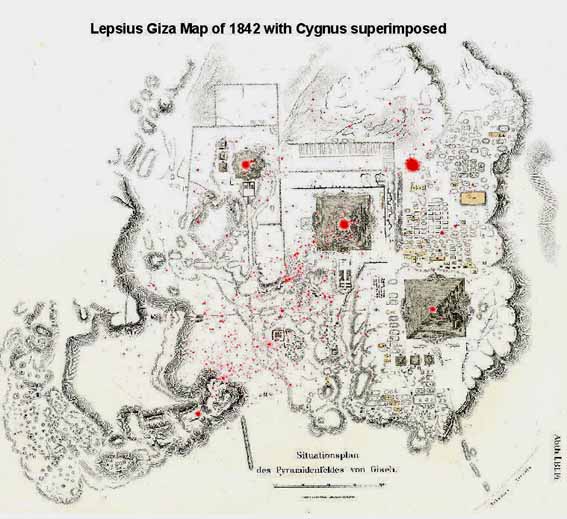
The Lepsius map of 1842 showing the Cygnus stars overlaid in red. Note the Deneb spot obscuring mastaba LG14 on the edge of the Western Cemetery (Pic credit: Nigel Skinner Simpson, with overlay courtesy of Rodney Hale).
Lepsius found the tomb to be devoid of any artefacts or inscriptions, and thus it was simply catalogued and forgotten about. Nothing more is currently known about LG14, and there is every chance that, if not pillaged in ancient times, it was built but never used. As such, no further light can be thrown on the Deneb spot, as we refer to it. Perhaps what we are looking for here is underground, or it is simply the position of a sight line overlooking the rest of the plateau. Either way, the Cygnus-Giza correlation should not be dismissed simply because Deneb does not hit anything obviously important, especially since Orion's own brightest stars, Rigel and Betelgeuse, fail themselves to mark any ancient monument.
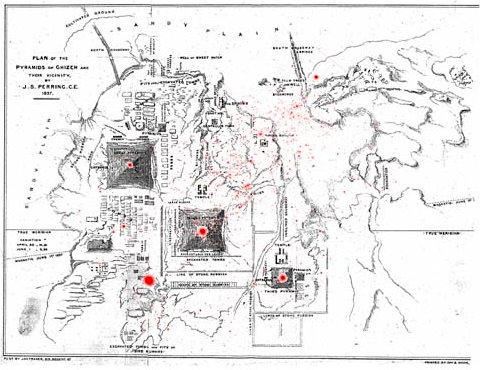
The John Perring's 1837 map of the Giza plateau. The Cygnus stars are in red. Note also the 'well' (Beer el-Samman) and 'sycamores' marked between the Great Sphinx and Gebel Ghibli. Note also the proximity of the 'beak star' Albireo (beta Cygni). Pic credit: Nigel Skinner Simpson with the overlay courtesy of Rodney Hale).
|
|
|
|
Rispondi |
Messaggio 6 di 101 di questo argomento |
|
THE PROPER MOTION OF STARS
One serious criticism of the Cygnus-Giza correlation related to the idea of a star's proper motion. This is the slow drift of extra-galactic stars against the background of other stars caused either by its movement in relation to its own galaxy, or because of earlier near collisions with other stars or stellar objects. It was a valid point, and so a check on the proper motion of Cygnus's key stars produced the following slow movements in any one year against the stellar background:
Alpha Cygni
RA: 0.003 arcsec/a or mas/yr
DEC: 0.002
Beta Cygni
RA: 0.002
DEC: -0.002
Delta Cygni
RA: 0.053
DEC: 0.047
Gamma Cygni
RA: 0,004
DEC: 0
Epsilon Cygni
RA: 356.16
DEC: 330.28
When this data is translated on to a map of the Cygnus constellation, the following takes place over the 4,000 year period from 2000 BC to AD 2000:
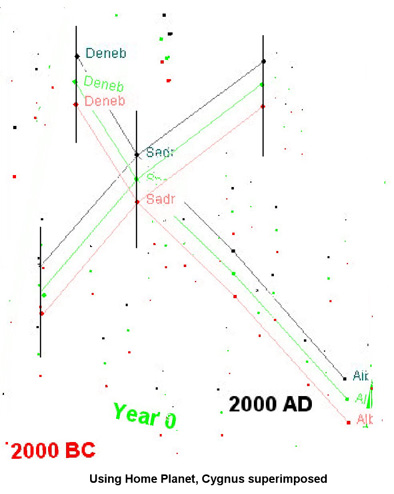
The proper motion of the principal stars of Cygnus over a period of 4,000 years,
from 2000 AD back to 2000 BC, using the Home Planet program (Pic credit: Rodney Hale).
Now all this might look confusing, but what it says is that, as Robert Bauval and Graham Hancock have said in connection with the 'belt' stars of Orion, there is no significant shift in the relative positions of the stars over this time. Only one star in Cygnus is moving faster than the rest, and this is Gienah (epsilon Cygni), which does shift slightly with respect to the Cygnus-Giza overlay, as is shown below.
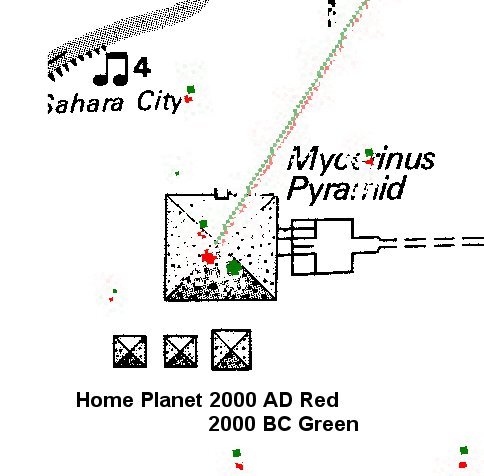
The relative shift of the star Gienah (epsilon Cygni) with respect to its position in relation to the Third Pyramid over a period of 4,000 years (pic credit: Rodney Hale).
As is plain to see, the shift is minimal, and does in no way change anything regarding the original proposal of the Cygnus-Giza correlation. The other two Cygnus 'wing' stars, delta Cygni, corresponding with the Great Pyramid, and Sadr (gamma Cygni), corresponding with the Second Pyramid, move so little that it is unnoticeable on a small scale map of the pyramid field. We are, however, not leaving the matter here. Rodney Hale and I shall continue to examine other astronomical programs that provide the proper motion of stars, and check to see whether they correspond with the shifts in position offered here.
THE RIGHT MAP
Another criticism of the Cygnus-Giza correlation was the suggestion that Rodney Hale and I had not used an accurate map of the plateau when creating the superimposition. In order to counter this argument, Rodney superimposed the 'wing' stars of Cygnus and the 'belt' stars of Orion over four different maps of the plateau, and then brought them together in one diagram (seen below). This shows the width of variations of pyramid positions relative to the stars of both Cygnus and Orion.
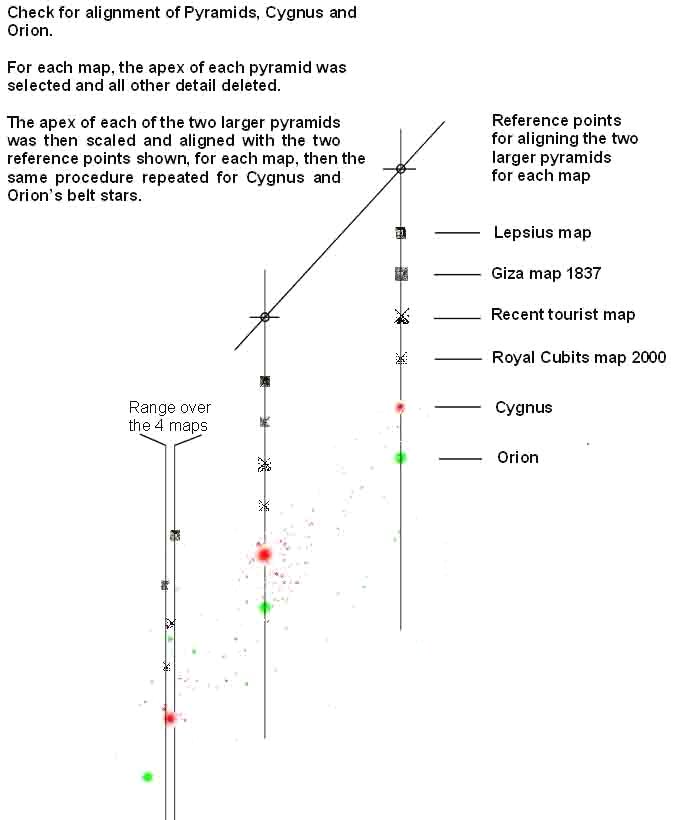
The variations of pyramid positions relative to the stars of both Cygnus (in red) and Orion (in green) using four different maps (Pic credit: Rodney Hale).
As we can see, there is very little difference in the positions of the pyramids from one map to the next, making no difference whatsoever to the relative positions of either the Cygnus or Orion stars when superimposed on the plateau. Without any question, the Cygnus stars align much better than those of Orion. Once again, such ground-sky correlations, if meaningful, might be symbolic alone, and not need to be actual, allowing still for the possibility that the three pyramids represent Orion and not Cygnus. However, visually Cygnus wins hands down. Rodney Hale and I will continue to consider other maps or photographs of the plateau with regards to the Cygnus-Giza correlation.
|
|
|
|
Rispondi |
Messaggio 7 di 101 di questo argomento |
|
THE HOLY WELL BEER EL-SAMMAN
The final criticism of the Cygnus-Giza correlation among the posts on the various online phorums was that the holy well Beer el-Samman never existed, or that it was irrelevant to the debate. These are quite clearly ridiculous observations. Not only does the well appear on the Perring map of 1837, which shows its location prior to the siting of the modern Islamic cemetery, but it also appears on the Lepsius map of 1842 (see below):
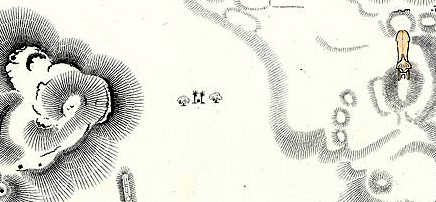
The well Beer el-Samman marked as a dot between two palm trees and two sycamore fig trees. On the left (south) we see the rock outcrop Gebel Ghibli (Arabic for 'southern hill'), and on the right the Great Sphinx. At the left-hand base is the end of the linear feature known as the Wall of the Crow (pic credit: Nigel Skinner Simpson).
There seems little question that this holy well would have played a function in Ancient Egyptian geomythics, especially since it falls inside the plateau, being placed as it is on the northside of the so-called Wall of the Crow, a linear stone feature made of cyclopean blocks which dates to the late Fourth Dynasty and is thought to be part of the plateau's southern boundary wall.
I consider it possible that Beer el-Samman is the structure referred to in the Edfu Building Texts as bw-hmn, which the Egyptologist EAE Reymond interpreted as 'place of the well' (THE ORIGINS OF THE EGYPTIAN TEMPLE, 181,200). I suspect it was in magical rites associated with Hathor, possibly a female patron of the plateau, and possibly Nut, the sky-goddess, whom Dr Robin Wells identifies with the Milky Way. It might equally have some connection with the cult of Sokar, who was guardian of underworld realms, which were forever in darkness.
Beer el-Samman corresponds with the Ain Shams (Eye of the Sun) holy spring that lies beneath an ancient sycamore fig at El Matariyeh, which once formed part of the ancient city of Heliopolis. This particular spring in Coptic Christian tradition is said to have sprung up miraculously when the Holy Family stopped here in need of water during the Flight through Egypt. However, it is more likely to date back to dynastic times, particularly as its accompanying sycamore is perhaps a descendent of one said to have existed in Heliopolis. It was sacred to the goddess Nut, who was occasionally shown in Ancient Egyptian art as standing in a sycamore tree pouring either water or wine from a jar on to a human-headed bird, representing the ba, or soul, of a deceased person. At its base was depicted just such a holy well, or spring. Often Hathor replaced Nut in this scene, showing the relationship between the two goddesses, who have much in common.
The dual placement of the two holy springs, one at Giza and the other at Heliopolis, one dedicated most probably to Hathor and the other to Nut, provides credence to the belief that a sight line existed between these two places. Between 3000-2500 BC this Giza-Matariyeh sight line targeted the rising of Deneb, the brightest star in Cygnus, which would have become visible on the northeast horizon somewhere between azimuth 46.5-47.5 degrees.
As to the present day existence of Beer el-Samman, this is proved by one of a number of photographs Sue Collins and I took of it in May 2005, after risking our freedom to enter the Islamic cemetery, which is strictly out of bounds to non-Muslims. As you can see it is a regular artesian well, stone lined, which taps into the water table beneath the plateau. I doubt very much whether it leads directly to a lost underworld domain, although it is interesting that the lowest level of the so-called 'Tomb of Osiris', discovered in the 1920s beneath the causeway to the Second Pyramid by Egyptologist Salim Hassan, possesses a pit thought to lead into an unexplored tunnel now beneath the present water table, this being high enough to fill the existing chamber to a depth of at least 1.5 metres. Could the story of the holy man Hamman el-Samman guarding the entrance to an underground palace or city be the memory of real passages that permeate the living rock beneath the plateau's water line?
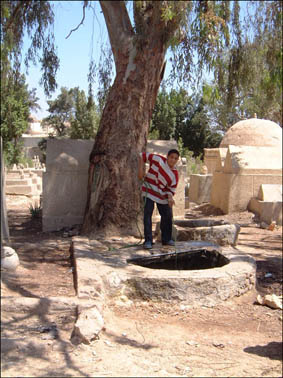
Beer el-Samman as it appears today in the Islamic cemetery, shaded by a sycamore fig tree.
Its proximity to Gebel Ghibli should be noted (pic credit: Andrew Collins)
Conclusions
One one question remains: does the Cygnus-Giza correlation work? In the knowledge that Dr Robin Wells, following an examination of the astronomical orientation of the causeway of Sahure's sun temple at Abu Ghourab, south of the Giza plateau, concluded that this king, who opened the Fifth Dynasty, singled out Deneb, Cygnus's brightest star, as in some way special, then I think the answer is going to be 'yes'. Yes, in that such superimpositions, whether involving the stars of Orion or Cygnus, put into perspective the hidden dimensions of places such as the Giza plateau. Part of me wants to dismiss the Cygnus-Giza correlation as the actions of the wily Cosmic Joker having his fun. Thus in conclusion, I consider that the Cygnus-Giza correlation has not hindered my investigations on the plateau in the least. In fact, it has given it an entirely new dimension that I now intend exploring to its fullest.
My thanks go out to Rodney Hale, Nigel Skinner Simpson, and Sue Collins who helped in the preparation of this article.
All Notes and References appertaining to this article are to be found in THE CYGNUS MYSTERY by Andrew Collins, which can be obtained by clicking here.

|
|
|
|
Rispondi |
Messaggio 8 di 101 di questo argomento |
|
Haz hecho público que te gusta. Deshacer
Haz hecho público que te gusta. Deshacer
Haz hecho público que te gusta. Deshacer
Haz hecho público que te gusta. Deshacer
Haz hecho público que te gusta. Deshacer1 publicación - 24 Oct. 2009
The Cygnus- Giza Correlation- New intersting theory, page 1. privacy. Pages: ATS Members have flagged this thread 1 times. Topic started on ...
Haz hecho público que te gusta. Deshacer
Haz hecho público que te gusta. Deshacer
|
|
|
|
Rispondi |
Messaggio 9 di 101 di questo argomento |
|
Haz hecho público que te gusta. Deshacer
- Notificar imágenesGracias por enviarnos los comentarios. Informa otra imagen.Informa la imagen ofensiva. CancelarListo
Haz hecho público que te gusta. Deshacer
books.google.com.ar/books?isbn=0876045719
... Orion Correlation Theory (OCT) ....................................................... 129 The Cygnus-Giza Correlation....................................................................... 130 Eye of the Bird .
|
|
|
|
Rispondi |
Messaggio 10 di 101 di questo argomento |
|
|
Abstract
This project is concentrate in the Swan Constellation. We have chosen to Cygnus because it allows us to enter in astronomy from two different aspects: the scientist and the humanist aspect. Going through the mythology, the art and the music we ride on that huge bird that begins to fly during summer nights.
In addition of the previous thing, this project is developed in three parts: where it is in the sky, a extensive description about it and a careful observation of this constellation. We will be able to find Cygnus thanks Deneb, one of its stars most bright. Deneb can be located by different methods like, for example, with the help of the Great Bear and the Polestar or observing the Triangle of Summer.
Of its description, we point out between its stars Deneb; Albireo, a double star situated in the tail of the swan; 61 Cygni, which was the first star whose distance to the Earth was measured correctly (by Bessel) and 16 Cygni, with its strange extrasolar planet. Also its clusters: M29 and M39 between some others as well as its more well-known nebula: 7000 NGC or Nebula of North America. The description finishes with a comparison among the Cross of the North and the Cross of the South because both of them have a similar form although their components have very different characteristics.
Finally we went to a place far from Madrid to avoid any kind of luminous contamination; first, with the only aid of our eyes and then with a telescope Meade LX 200 GPS, we fill our notebook and really, we spent a magical night observing the sky.
|
|
|
|
|
|
|
Resumen
El proyecto se centra en la constelación del Cisne. Hemos elegido a Cygnus porque nos permite adentrarnos en la astronomía desde dos aspectos: el científico y el humanístico. A través de la mitología, el arte y la música nos introducimos en la enorme ave que echa a volar durante las noches estivales.
El trabajo, además de lo anterior, se desarrolla en tres partes: localización en el cielo, descripción de la constelación y observación de la misma.Encontramos el cisne gracias a Deneb, su estrella más brillante. Ésta la localizamos, bien con ayuda de la Osa Mayor y la Polar, o bien observando el Triángulo de Verano.
De su descripción, destacar entre sus estrellas: Deneb, Albireo (estrella doble situada en la cola del cisne), 61 Cygni, que fue la primera estrella a la que se la midió su distancia a la Tierra de manera acertada (gracias a Bessel) y 16 Cygni con su peculiar exoplaneta. También sus cúmulos: M29 y M39 entre algunos otros, así como su nebulosa más conocida: NGC 7000 o Nebulosa de Norteamérica. Se termina la descripción, comparando la Cruz del Norte con la Cruz del Sur, ya que ambas tienen un asterismo similar, aunque sus componentes tienen características muy diferentes.
Por último, lejos de Madrid para evitar la contaminación lumínica y, primero a simple vista, y luego con un telescopio Meade LX 200 GPS, llenamos nuestro cuaderno de notas y en definitiva, pasamos una noche mágica observando el cielo.
|
|
|
|
|
Desarrollo
El cielo y sus componentes han resultado ser una gran incógnita para el hombre, sobre la cual se planteaban preguntas cuyas respuestas se llevan buscando desde tiempos remotos.También,el cielo se ha considerado un lugar de abstracción en el cual puedes evadirte hacia lugares nunca vistos.
En tiempos lejanos, en los que los árabes eran los dueños del saber, el cielo que parecía estar al alcance de la mano era observado fervientemente. Durante esta época los maestros del firmamento alzaban sus ojos para observar diversas figuras que ahora conocemos como las constelaciones. Entre ellas, descubrieron una enorme ave que echaba el vuelo durante las noches estivales.
|
|
Pasados unos siglos, los griegos reconocieron a este animal como un sorprendente cisne situado en el cielo por los mitos de la época.
Para conocer alguna de estas leyendas pincha sobre las imágenes.
|

|

|
A través de los tiempos, este cisne ha continuado su vuelo en dirección suroeste sobre el Camino de Santiago, que simboliza la Vía Láctea. Actualmente los astrónomos deben trasladarse al hemisferio norte y esperar al verano para poder contemplar su belleza. Esta constelación ocupa 806º cuadrados en la bóveda celeste. Este dato la clasifica en el decimosexto lugar por su tamaño. Se encuentra a 4000 años luz de la Tierra y también se la conoce con su nombre latino Cygnus y con el de Cruz del Norte por su disposición en forma de cruz. Ptolomeo identificó esta constelación y la incluyó en su obra maestra:”Almagesto”, así como hizo con su principal estrella, actualmente conocida gracias a los árabes como Deneb. Este astrónomo la designó dentro de su obra como alfa-Cygni.
Desde el Renacimiento hasta la actualidad esta constelación se encuentra en diversas representaciones artísticas como tema recurrente.
|
|
|
|
|
A la hora de localizar esta constelación en la bóveda celeste tomaremos como referencia algunas estrellas muy brillantes y constelaciones fácilmente reconocibles. Así comenzaremos nuestra búsqueda localizando la Osa Mayor. Esta constelación es una de las referencias más usadas para orientarnos en el cielo nocturno pues tiene una forma característica de carro que la hace muy reconocible.
|
|

|
También nos permite localizar a la Estrella Polar de forma rápida y precisa. Es por esto por lo que la hemos elegido para iniciar nuestra búsqueda.
Para localizar a la Estrella Polar a partir de la Osa Mayor, uniremos con una línea imaginaria, las estrellas de la parte delantera del carro (alfa y beta) y prolongamos la distancia que las separa cinco veces sobre la dirección que indica el gráfico. La estrella más brillante será la Polar, que forma parte de la Osa Menor.
|
|
|

|
Una vez localizada la Estrella Polar es muy fácil encontrar Deneb y con ella a la constelación del Cisne.
Para ello uniremos alfa y beta y la Polar formando una línea imaginaria que trazaremos y otra desde esta última formando un ángulo de 155º.
Deneb forma parte de una región del cielo conocida como “triángulo de verano o triángulo estival” junto con Vega en la constelación de Lira y Altair en constelación del Águila.
|
|
|

|
Este triángulo es una de las zonas más vistosas del universo pues es rica en estrellas débiles y está atravesada por la Vía Láctea. Si quisiéramos localizarlo sería necesario ubicar a Vega. Para ello, llevaríamos a cabo los mismos pasos que con la localización de Deneb, solo que a la hora de trazar la segunda línea imaginaria lo haremos tomando un ángulo de 114º.
Una vez localizadas Deneb y Vega tendríamos prácticamente localizado al “triángulo estival” pues la unión de estas dos constituye la base del triángulo isósceles que forma esta región celeste.
|
|
|
|
- CONSTELACIONES LIMÍTROFES A CYGNUS
Las constelaciones que rodean a Cisne en la bóveda celeste son:
LIRA: es una pequeña constelación visible en agosto situada al oeste de Cygnus. A pesar de su tamaño es fácilmente reconocible ya que tiene una estrella muy brillante: Vega, que forma parte del Triángulo de Verano. Entre los diversos objetos del cielo profundo que encontramos en Lira podemos destacar:
- La nebulosa anular de Lira
- El cúmulo globular M56 y el cúmulo abierto NGC 6791
- Las estrellas variables RR Lyrae y Beta Lyrae
LACERTA: también conocida como constelación del Lagarto. Es una de las constelaciones menores y se encuentra situada al este de Cygnus.
VULPÉCULA: es la constelación que simboliza al zorro. Sen encuentra situada en el centro del Triángulo de Verano. Contiene a la nebulosa planetaria M27 y un cúmulo abierto Collinder 399, también conocido como La Percha.
DRACO: simboliza al dragón y está al noroeste del Cisne.
PEGASO: es una de las 88 constelaciones modernas y una de las 48 que describió Ptolomeo. Recibe su nombre del Pegaso mitológico, un caballo alado. Posee el clúster globular M15, dos galaxias (NGC 7331, que es la más brillante de la constelación, y la NGC 7742) y la estrella 51 Pegasi, el primer planeta extrasolar descubierto.
|
|
|
|
|
Rispondi |
Messaggio 11 di 101 di questo argomento |
|
- COMPONENTES DE CYGNUS: La Constelación del Cisne está formada por diversas estrellas, cúmulos, nebulosas y un agujero negro muy reconocido.
1. ESTRELLAS:
|
|

|
Deneb (alfa - Cygni) : Es la estrella más brillante de Cygnus. Su nombre significa “cola” y se sitúa en esta parte del cisne.
- Es una supergigante blanca de magnitud 1,25.
- Dista de la tierra 3.230 años-luz.
- Su tamaño es 60 veces el tamaño del Sol, sin embargo, su masa es 25 veces menor. Su superficie está a 9.700 ºK.
- Su espectro corresponde a la clase A.
- Se considera una posible nova.
|
|

|
Albireo (beta – Cygni): Significa “pico de ave” y se sitúa como su nombre indica, en la cabeza del cisne.
- Es una estrella doble separadas 34 segundos una de otra.
- Beta Cygni B es azul, con magnitud aparente 3’4 y espectro clase B
- Beta Cygni A es amarillo rojiza, de magnitud aparente 5’1 y espectro clase K. Es, a su vez una estrella binaria.
- Se encuentra a 386 años-luz.
|
|

|
Sadr (gamma- Cygni): Significa “pecho” y se sitúa en la zona del tronco del cisne.
- Es una estrella amarilla supergigante con una luminosidad de magnitud 2’2.
- Su distancia a la Tierra es de 1.524 años-luz.
- Su masa es aproximadamente 10 veces la del Sol y su diámetro unas 10 veces mayor.
- Su espectro corresponde a la clase F.
- Enel año 7400 el Polo Norte de la Tierra estará cercano a esta estrella.
|
|

|
Azelfafabe (pi - Cygni) Su nombre árabe es traducido por “garganta” y se sitúa en el cuello del cisne.
- Su magnitud es 4’8 y su espectro es de clase B.
- La distancia a la Tierra es de 1.681 años-luz.
Gienah cygni (Epsilon - Cygni):Significa“ala” y, por tanto, se sitúa en una de las alas del cisne.
- Su luminosidad es de magnitud 2’ 47 y su espectro es de clase K.
- Dista de la Tierra es de 72 años-luz.
Ruchba (Delta - Cygni): Se localiza en el otro ala del cisne.
- Su luminosidad es de magnitud 5’ 44 y su espectro de clase A.
- Dista de la Tierra es de 870 años-luz.
|
|

|
61 Cygni: Conocida como Piazzi, su descubridor en 1792.
- Es una estrella doble formada por dos estrellas separadas por un arco de 29 “. La máxima separación, 34”, ocurrirá en el año 2100.
- Existen otras tres compañeras invisibles con períodos orbitales cortos (¿posibles planetas?).
- Bessel determinó su situación a 11’2 años-luz del Sistema Solar, siendo la primera estrella de la que se midió su distancia por el método de paralaje.
- Su espectro es clase K y su periodo orbital de 650 años.
|
|

|
16 Cygni B: Es una de las estrellas más parecidas a nuestro Sol.
- Se encuentra a 85 años luz de nuestro Sistema Solar.
- Es una enana amarilla, con espectro G y luminosidad 1’33.
- Alrededor de ella existe un planeta con masa 1’6 veces mayor que Júpiter. Este exoplaneta tiene una órbita muy excéntrica, siendo la distancia mínima a la estrella de 0’6 Unidades Astronómicas.
|
|
|
|

|

|
|
Es una aglomeración de pequeño tamaño, de estrellas jóvenes con tipo espectral O y B. Presenta una disposición cuadrada o romboidal con dos extensiones a los lados. Sus cuatro estrellas blanco azules más brillantes tienen una magnitud 8-9. Entre ellas se encuentra el resto, 16, más débiles.
|
|

|

|
|
Fue descubierto por Messier en 1764 pero también se dice que, al ser visible incluso a simple vista desde un lugar oscuro, Aristóteles ya lo describió en el año 325 a.C.
Se observan claramente media docena de estrellas blancas brillantes y otras 12, menos brillantes y amarillentas, que también son visibles.
|
|

|

|
-
NGC 6811: Es un cúmulo abierto que se encuentra a 4º al sur de la nebulosa 6826 y al noreste de Delta Cygni.Tiene un tamaño mediano. Su forma es peculiar, ya que tiene cuatro condensaciones que parecen una pequeña casita con tejado coronado con una luminaria brillante de magnitud 6,8 que destaca sobre las demás.El interior de estas cuatro formaciones está menos provisto de estrellas.
|
3. NEBULOSAS:
Al igual que todas las planetarias brillantes, cuando se intenta visualizar con pocos aumentos, se la aprecia como una estrella enana blanca desenfocada y borrosa, mientras que si se le aplica 120 aumentos o más se puede observar su forma circular muy brillante en el centro y bordes difusos a modo de corona. No se distingue color, simplemente una tonalidad blanquecina.
|
|
|
|
 |
Emite grandes cantidades de radiación ultravioleta debido a su altísima temperatura, lo que ioniza el gas en expansión de la nebulosa y la hace brillar.
|
|
Un aspecto interesante de este objeto estelar es que si focalizamos sobre el centro de la nebulosa y, alternativamente miramos lateralmente (como por el rabillo del ojo), nos da la sensación de que parpadeara. Por eso, se la conoce también como “planetaria parpadeante”.
- NEBULOSA DEL VELO: Es también conocida como Lazo del Cisne, es un complejo de nebulosas cuya estructura solo se puede apreciar mediante grandes telescopios. Está formada por NGC 6960 situada al oeste y por NGC 6992 situada al este y por NGC 6979 y NGC 6995. Fue descubierta en 1784 por Herschel.
Diez mil años antes de la aparición del hombre sobre la Tierra, una gran luz apareció en el cielo y desapareció a las pocas semanas. Era una estrella masiva que explotaba y dejaba una nube en expansión. Es una nebulosa de emisión. Tiene un diámetro aparente de 2’6º que corresponden a un tamaño real de 70 años luz y se encuentra a unos 2.600 años luz de la Tierra.
|
|
 |
|
 |
|
|
|
| |
NGC 6960
|
NGC 6992 y NGC 6995
|
|
|
|
Al lado de la estrella 52 Cyg, se vislumbra una luminosidad de aspecto circular arqueada. Es NGC 6960 y se la conoce informalmente como la nebulosa Escoba de Bruja. Tiene un poco más de tres veces el tamaño angular de la Luna llena y está a unos 1400 años-luz de nosotros. En la imagen, el resplandor central corresponde a 52 Cyg. Si giramos 2º hacia el este encontramos NGC 6992 y NGC 6995. Se conocen con el nombre de nebulosa del Encaje. Tienen una forma más alargada y ancha pero también más tenue y, por tanto, más difícil de visualizar.
|
|
|
|
 Primo
Primo
 Precedente
2 a 11 de 101
Successivo
Precedente
2 a 11 de 101
Successivo Ultimo
Ultimo
|

